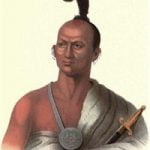
A Saukie Brave (Sauk)
This distinguished warrior is the chief of a division of the Saukie nation, which forms part of a singular institution, that, so far as we know, is peculiar to that people.
The warriors of the Saukie nation are divided into two bands, or parties, one of which is called Kishkoquis, or the Long Hairs, and the other Oshcush, or the brave; the former being considered as something more than merely brave. In 1819 each party numbered about four hundred warriors; in 1826 they numbered about five hundred each, but have not increased since that time. The Kishkoquis, or Long Hairs, are commanded by the hereditary war chief Keokuk, whose standard is red; the head man of the Oshcushies is Kaipolequa, the subject of this sketch, whose standard is blue. The Long Hairs take precedence in point of rank. The formation of these parties is a matter of national concern, and is effected by a simple arrangement. The first male child who is born to a Kishkoqui, is marked with white paint, the distinguishing color of the Kishkoquis, and belongs to that party; the next male of the same family is marked with black paint, and is attached to the Oshcushies, and so on alternately the first son belonging to the same band with his father, and the others being assigned in turn, first to one band, and then to the other. Thus all the warriors are attached to one or the other band, and the division is as nearly equal as it could be by any arrangement commencing with infancy.
Whenever the whole nation, or any large party of warriors, turns out to engage in a grand hunt, or a warlike expedition, or for the purpose of performing sham battles, or ball plays, the individuals belonging to the two bands are distinguished by their appropriate colors. If the purpose of the assemblage is for sham fighting, or other diversion, the Kishkoquis daub their bodies all over with white clay, and the Oshcushies blacken themselves with charcoal; the bands are ranged under their respective leaders, and play against each other, rallying under the red and blue banners. In war and hunting, when all must be ranged on one side, the white and black paints are mingled with other colors, so that the distinction is kept up, and after the close of the expedition, the scalps, plunder, game, and other trophies of each band collectively, are compared, and the deeds of each repeated.
The object of these societies will be readily seen. They form a part of the simple machinery of a military government, and are founded in consummate wisdom, with the view of exciting emulation, and of placing every warrior in the nation under the constant observation of all the others. From early youth each individual is taught to feel, that, whether engaged in war, in hunting, or in athletic sports, the honor of his band, as .well as his own, is concerned in his success or failure, and thus a sense of responsibility is awakened and kept alive, which has all the moral force of a constant and rigid discipline.
Kaipolequa attained the high rank of leader of his band through his military abilities; and he is considered as one of the most distinguished braves of the nation.
